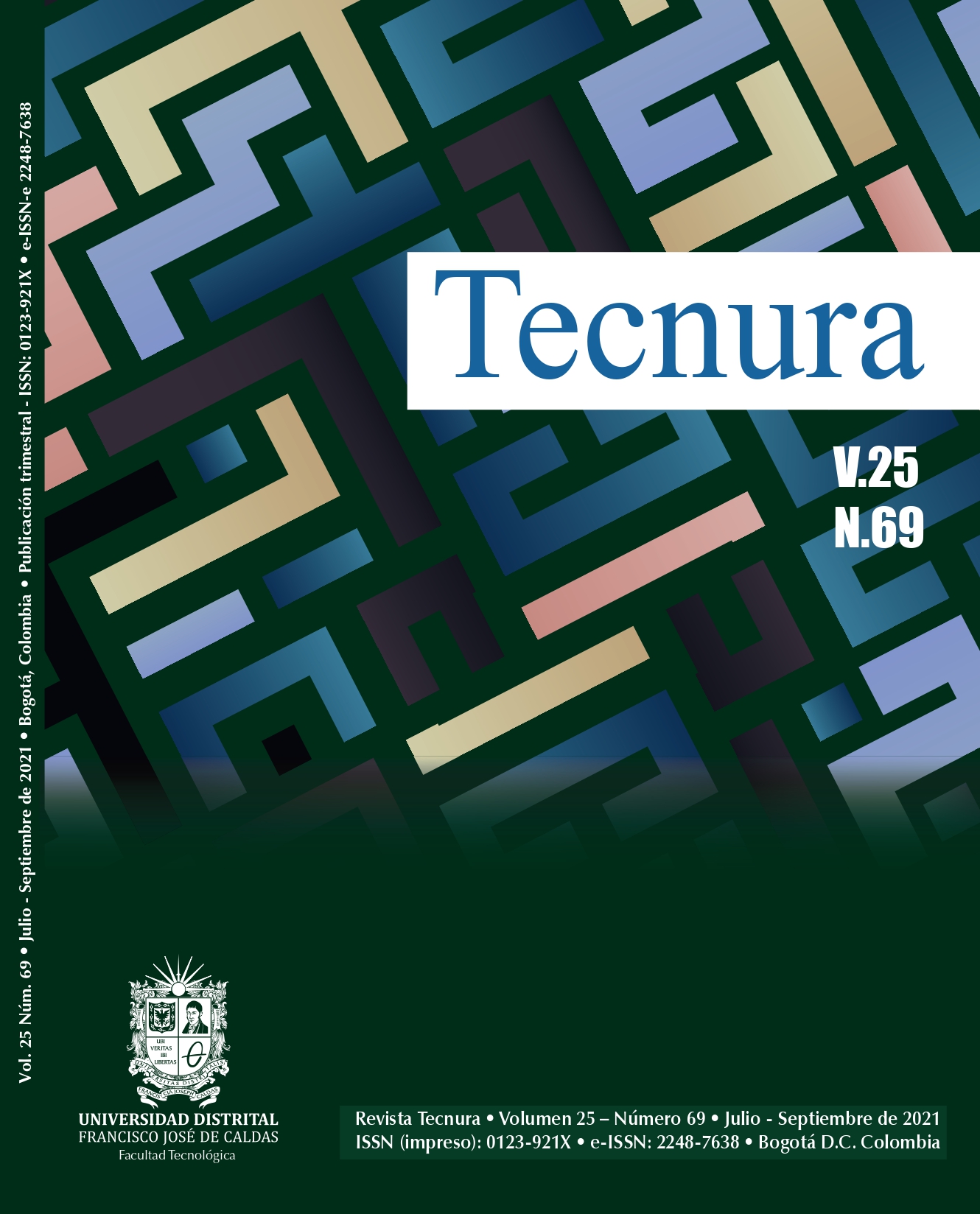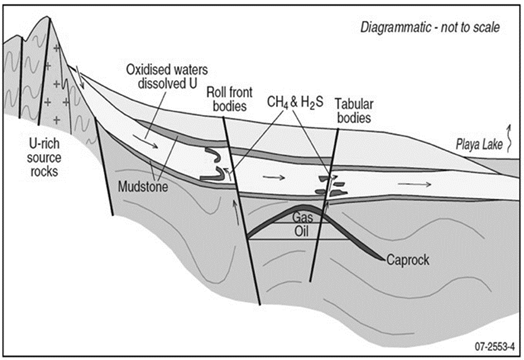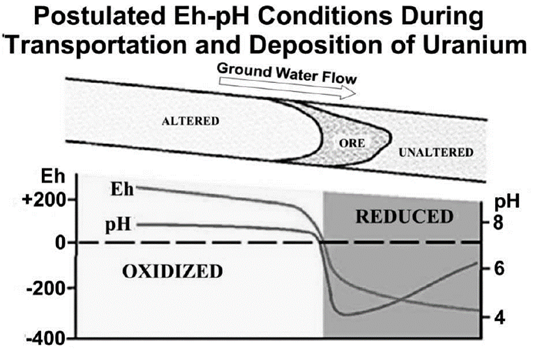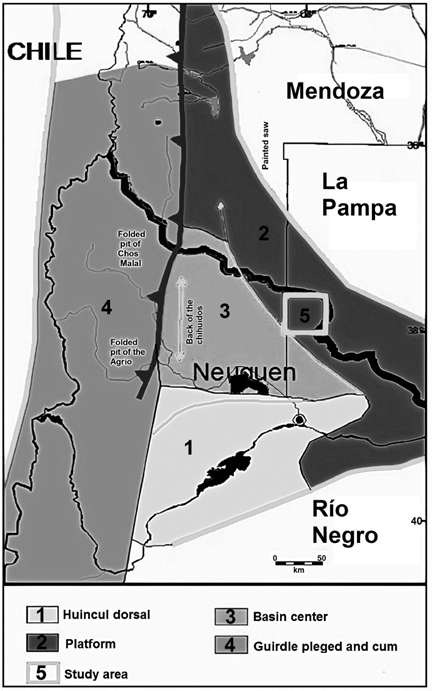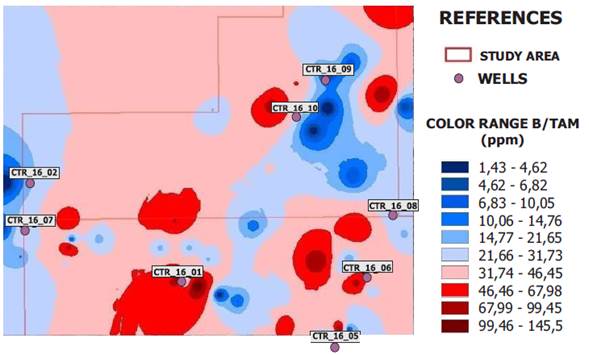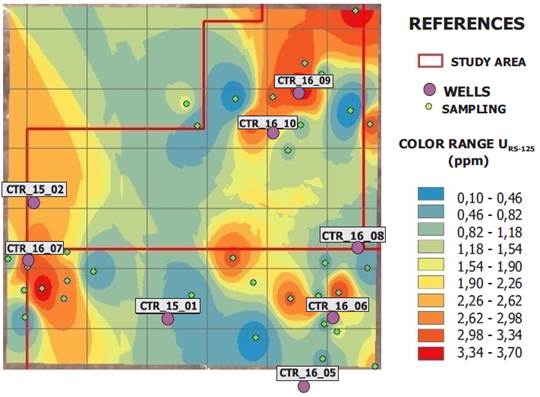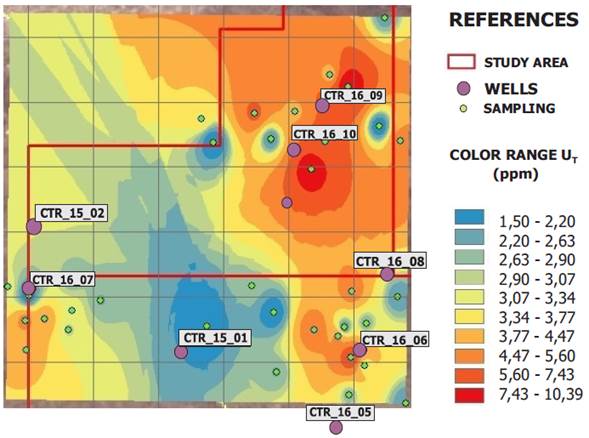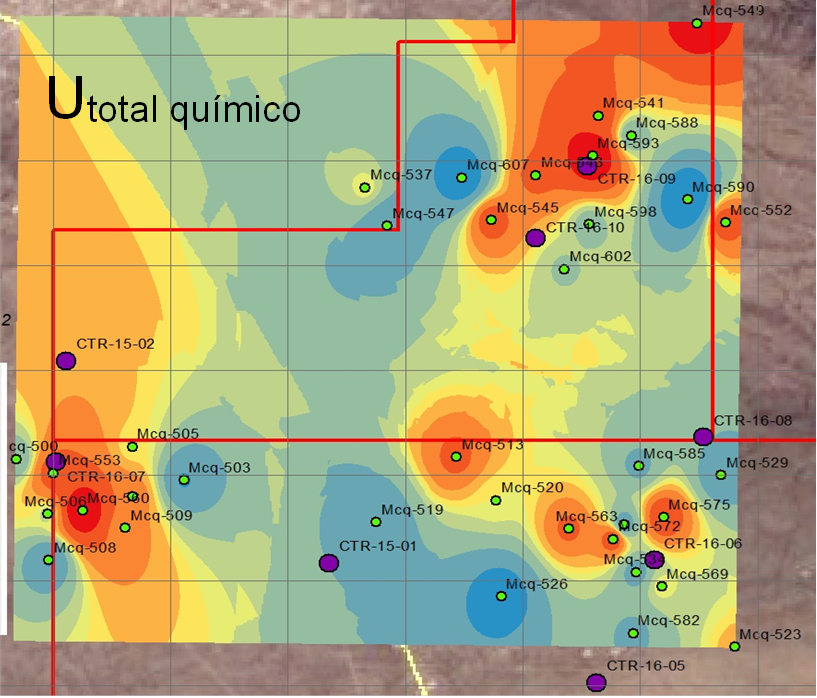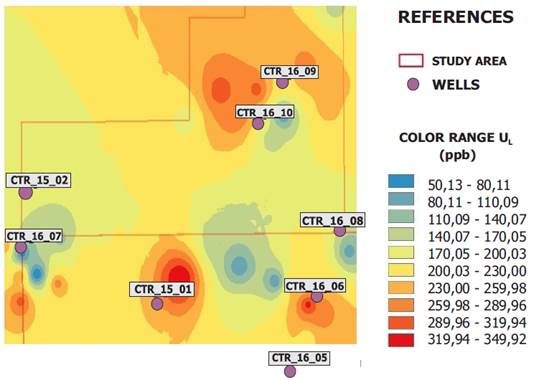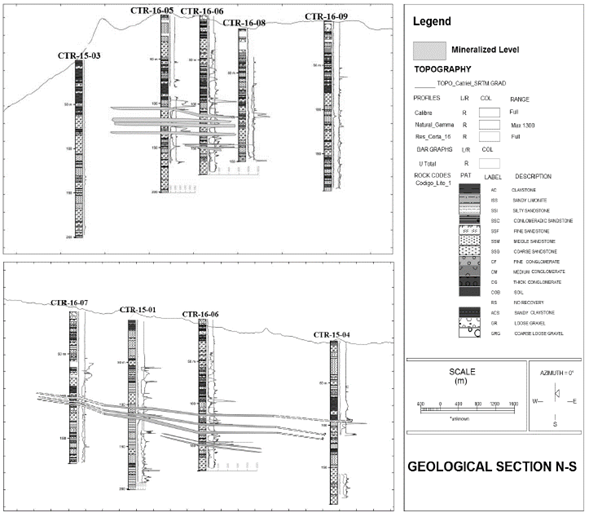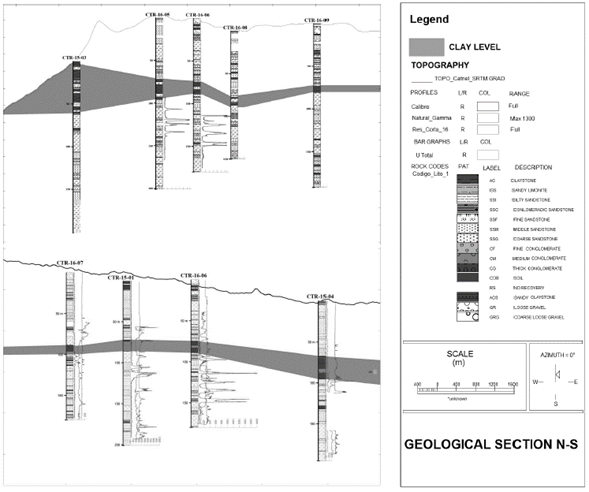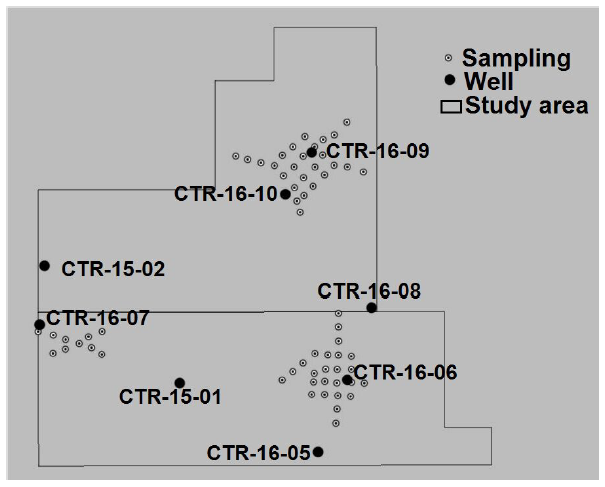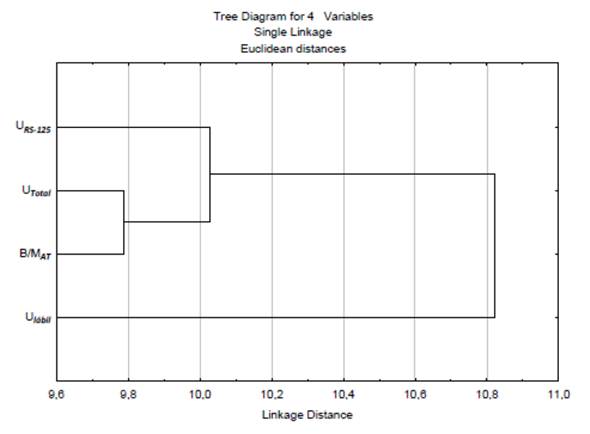DOI:
https://doi.org/10.14483/22487638.17059Published:
2021-07-01Issue:
Vol. 25 No. 69 (2021): July - SeptemberSection:
ResearchGeomicrobiología para prospección de uranio en profundidad en la cuenca Neuquina, Argentina
Geomicrobiology for Deep Uranium Prospection in the Neuquina Basin, Argentina
Keywords:
Cuenca Neuquina, Organismos biológicos, Prospección, Uranio (es).Keywords:
Neuquina Basin, Biological organisms, Prospection, Uranium (en).Downloads
References
Batista-García, R. A., Quesada-Quintero, A. L., Sánchez-Reyes, A., López-Guerra, S., & Domínguez-Saliñas, Z. (2011). Microbiología y biotecnología aplicadas a la exploración y producción petroleras. Revista CENIC. Ciencias Biológicas, 42,(1), 35-41. ISSN: 0253-5688 Editorial CENIC, La Habana, Cuba. https://www.redalyc.org/pdf/1812/181221683007.pdf
Brodtkorb, M. (1966). Mineralogía y consideraciones genéticas del yacimiento Huemul, provincia de Mendoza. Revista de La Asociación Geológica Argentina, XXI(3), 165-179. ISSN 00044822. URL: https://revista.geologica.org.ar/raga/issue/view/170/93
de Vasconcellos, S. P., Crespim, E., da Cruz, G. F., Senatore, D. B., Simioni, K. C. M., dos Santos Neto, E. V., Marsaioli, A. J., & de Oliveira, V. M. (2009). Isolation, biodegradation ability and molecular detection of hydrocarbon degrading bacteria in petroleum samples from a Brazilian offshore basin. Organic Geochemistry, 40(5), 574-588. https://doi.org/10.1016/j.orggeochem.2009.02.006 DOI: https://doi.org/10.1016/j.orggeochem.2009.02.006
DuTeau, N. M., Rogers, J. D., Bartholomay, C. T., & Reardon, K. F. (1998). Species-Specific Oligonucleotides for Enumeration ofPseudomonas putida F1, Burkholderia sp. Strain JS150, and Bacillus subtilis ATCC 7003 in Biodegradation Experiments. Applied and Environmental Microbiology, 64(12), 4994-4999. https://doi.org/10.1128/AEM.64.12.4994-4999.1998 DOI: https://doi.org/10.1128/AEM.64.12.4994-4999.1998
Horvitz, L. (1939). On geomicrobial prospecting. Geophysics, 4, 210-228. https://doi.org/10.1190/1.1440497 DOI: https://doi.org/10.1190/1.1440497
Hubert, C., & Judd, A. (2010). Using Microorganisms as Prospecting Agents in Oil and Gas Exploration. In Timmis, K. N. (Ed.) Handbook of Hydrocarbon and Lipid Microbiology. Springer. https://doi.org/10.1007/978-3-540-77587-4_201 DOI: https://doi.org/10.1007/978-3-540-77587-4_201
International Atomic Energy Agency (IAEA). (2001). GNIP Maps and Animations. International Atomic Energy Agency.
Jaireth, S., McKay, A., & Lambert, I. (2008). Association of large sandstone uranium deposits within hydrocarbons. AusGeo News, 89. http://www.ga.gov.au/ausgeonews/ausgeonews200803/uranium.jsp
Karkanis, C. (2016). Informe Ejecutivo de prospección geoquímica de los cateos próximos a la localidad de Colonia Catriel, provincia de Río Negro y del cateo Lucas, provincia de La Pampa. Informe Interno. CNEA.
Karkanis, C. (2018). Informe Técnico. CNEA.
Landais P. (1989). Biodegradation of oils in uranium deposits,Metallogenesis of uranium deposits: proceedings of a Technical Committee Meeting on Metallogenesis of Uranium Deposits / organized by the International Atomic Energy Agency and held in Vienna, 9-12 March 1987. The Agency. https://inis.iaea.org/search/search.aspx?orig_q=RN:20084211
Llambías, E. J., Quenardelle, S., & Montenegro, T. (2003). The Choiyoi Group from central Argentina: A subalkaline transitionalto alkaline association in the craton adjacent to the active marginof the Gondwana continent. Journal of South American Earth Sciences, 16(4), 243-257. https://doi.org/10.1016/S0895-9811(03)00070-1 DOI: https://doi.org/10.1016/S0895-9811(03)00070-1
McLee, A. G., Kormendy, A. C., & Wayman, M. (1972). Isolation and characterization of n -butane-utilizing microorganisms. Canadian Journal of Microbiology, 18(8), 1191-1195. https://doi.org/10.1139/m72-186 DOI: https://doi.org/10.1139/m72-186
Narváez-Flórez, S., Gómez, M. L., & Martínez, M. M. (2008). Selección de bacterias con capacidad degradadora de hidrocarburos aislados a partir de sedimentos del Caribe colombiano. Boletín de Investigaciones Marinas y Costeras, 37(1), 61-75. https://doi.org/10.25268/bimc.invemar.2008.37.1.182 DOI: https://doi.org/10.25268/bimc.invemar.2008.37.1.182
Pourbaix, M. (1974). Atlas of electrochemical equilibria in aqueous solutions. National Association of Corrosion. https://doi.org/10.1007/978-1-4684-1806-4_4 DOI: https://doi.org/10.1007/978-1-4684-1806-4_4
Rasheed, M. A., Hasan, S. Z., Srinivasa Rao, P. L. S., Boruah, A., Sudarshan, V., Kumar, B., & Harinarayana, T. (2014). Application of geo-microbial prospecting method for finding oil and gas reservoirs. Frontiers of Earth Science, 9, 40-50. https://doi.org/10.1007/s11707-014-0448-5 DOI: https://doi.org/10.1007/s11707-014-0448-5
Rasheed, M. A., Veena Prasanna, M., Satish Kumar, T., Patil, D. J., & Dayal, A. M. (2008). Geo-microbial prospecting method for hydrocarbon exploration in Vengannapalli Village, Cuddapah Basin, India. Current Science, 95(3).URL: https://www.jstor.org/stable/24102760
Rojas, G. (2013, October 16-18). Depósitos de uranio en areniscas fluviales y marino marginales en la plataforma de la cuenca Neuquina [Conference presentation]. X Congreso de Geología Económica, San Juan, Argentina.
Joshi, S., Barucha, C., & Desai, A. J. (2008). Production of biosurfactant and antifungal compound by fermented food isolated Bacillus subtilis. Bioresource Technology, 99(11), 4603-4608. https://doi.org/10.1016/j.biortech.2007.07.030 DOI: https://doi.org/10.1016/j.biortech.2007.07.030
Scotti A., Rojas, G., & Servant M., C. P. (2019). Geomicrobiología para prospección de Uranio en profundidad. In CNEA (Eds.), Actas Resúmenes E-ICES 14. CNEA.
Song, J., Han, B., Song, H., Yang, J., Zhang, L., Ning, P., & Lin, Z. (2019). Nonreductive biomineralization of uranium by Bacillus subtilis ATCC-6633 under aerobic conditions. Journal of Environmental Radioactivity, 208-209, 106027. https://doi.org/10.1016/j.jenvrad.2019.106027 DOI: https://doi.org/10.1016/j.jenvrad.2019.106027
Tucker, J., & Hitzman, D. (1994). Detailed microbial surveys help improve reservoir characterization. Oil and Gas Journal, (United States) 92(23). OSTI Identifier 7013411- ISSN 0030-1388- URL: https://www.osti.gov/biblio/7013411
Valle, N. (2016). Informe Técnico CNEA. CNEA.
Zhao, L., Cai, C., Jin, R., Li, J., Li, H., Wei, J., Guo, H., & Zhang, B. (2018). Mineralogical and geochemical evidence for biogenic and petroleum-related uranium mineralization in the Qianjiadian deposit, NE China. Ore Geology Reviews, 101, 273-292. https://doi.org/10.1016/j.oregeorev.2018.07.025 DOI: https://doi.org/10.1016/j.oregeorev.2018.07.025
How to Cite
APA
ACM
ACS
ABNT
Chicago
Harvard
IEEE
MLA
Turabian
Vancouver
Download Citation
Recibido: 2 de noviembre de 2020; Aceptado: 1 de abril de 2021
RESUMEN
Contexto:
La prospección microbiológica de petróleo es una metodología ampliamente utilizada y se describe en muchos trabajos publicados, sin embargo en la minería de uranio (U) no es frecuente, si bien hay investigadores que se refieren a algunos microorganismos como Bacillus sp, los cuales se utilizan en biorremediación y podrían ser capaces de hacerlo en prospección. En este trabajo se propone una relación microbiológica para la prospección por U, hipotetizando que se verá afectada por la presencia de U profundo Nuestro objetivo principal es mostrar que la relación microbiológica formada por Bacillus sp /Mesófilos Aerobios Totales (B/TAM) se relaciona con la presencia de U y se puede utilizar como técnica complementaria para su prospección.
Método:
El muestreo de suelo fue realizado en un área de 600 Km2 en la cuenca Neuquina; Colonia Catriel, Provincia de Río Negro, Argentina. Para las determinaciónes de U espectrométrico, U total, U lábil y la microbiología, se muestrearon 62 sitios por duplicado y se estudiaron 8 pozos con diferente concentración de U en profundidad. Además, se analizaron la emanometría de Radón y las zoneografías de las concentraciones de U total, lábil y espectrométrico y de la relación microbiológica. Los resultados se sometieron a un análisis estadístico mediante análisis de componentes principales y regresión lineal.
Resultados:
Este trabajo muestra una lineal correlación estadística altamente significativa (R= 0,59 p< 0,002) entre la geomicrobiología en superficie y la concentración de U en profundidad.
Conclusiones:
Las investigaciones deben continuar vinculando otros elementos de la geoquímica y de la geofísica que podrían complementarse con esta técnica geomicrobiológica.
Palabras clave:
Cuenca Neuquina, organismos biológicos, prospección, uranio..ABSTRACT
Context:
Microbiological prospecting for oil is a widely used methodology and is described in many published works. In uranium (U) mining it is not frequent, although there are some researchers who refer to some microorganisms as Bacillus sp, which are used in bioremediation and they could be able to do it in prospection. In this work we propose a microbiological relationship for prospection by U, hypothesizing that it will be affected by the presence of deep U. The main objective of this work is to show that the microbiological relationship formed by Bacillus sp /Total Aerobic Mesophiles (B/TAM) is related to the presence of U and it be able to use as complementary technique for prospection by U.
Methodology:
The soil sampling carried covers an area of 600 Km2 into oil-uraniferous Neuquina basin; it is near to the town of Colonia Catriel, Province of Río Negro, Argentina. Spectrometric U, total chemical U, labile U and microbiological determinations from 62 sites with sampling by duplicated and 8 wells with different U concentration in depth were studied. Furthermore, Radon Emanometry and Zoneograms of total, labile and spectrometric U concentrations and of the microbiological relationship were analyzed. Results were subjected to a statistical analysis using principal components and linear regression.
Results:
This work shows a highly significant statistical linear correlation between geomicrobiology on surface and U concentration in depth (R= 0,59 p<0,002).
Conclusion:
Research should continue to link other elements from geochemistry as well as geophysical characteristics that could be complemented with this geomicrobiological technique.
Keywords:
Neuquina basin, biological organisms, prospection, uranium..INTRODUCTION
The association of uranium (U) mineralization with bitumen is widely known in numerous deposits of this element. Although oil cannot be considered as a source of U or as the fluid that transports it, it is a fundamental element for its precipitation.
In the province of La Pampa, to the northeast and east of the study area, Llambías et al., (2003) recognize two igneous suites for the Choiyoi Group (Permo-Triassic), one shoshonitic and the other trachydacitic to rhyolitic. The shoshonitic suite presents high contents of Thorium (Th) and U, and the rocks associated with this suite could constitute the uranium source for the proposed model (Figure 1).
Figure 1: Diagram of uraniferous mineralization in the presence of hydrocarbons (Jaireth et al., 2008)
Figure 2: Graph of Eh-pH conditions during U transport and deposition, modified from (Pourbaix, 1974)
The biodegradation of oils associated with U mineralization was observed in various worldwide deposits, for example, in Temple Mountain, Utah, and in Grand Canyon, Arizona, both in the United States of America, as well as in Lodève, Francia (Landais, 1989). In Argentina, the close relationship of U with heavy oil has been verified at the Huemul deposit, which is located in the department of Malargüe, Mendoza. It is the only national example, and it has been exploited by CNEA for several decades (Rojas, 2013). The mineralization and the genesis of the deposit were studied in several works. Particularly, Brodtkorb (1966) determined the existence of four types of heavy oil as asphalt, discriminated by their optical properties. Only one of them was the carrier of pitchblende (Uraninite), which is the predominant mineral in the mine. Subsequent studies worldwide conclusively determined that this reducing capacity, on favorable conditions of Eh and pH (Figure 2), is given by a process of progressive destruction of linear hydrocarbons, thus leaving a viscous and heavy residue. Biodegraded oils are known to be present in the Neuquina basin, and its shallow sectors show noticeable effects of this process, mainly, in those near the edges of the basin, also called platform (Figure 3). This is an example of the fact that biodegradation is a regional phenomenon, given the wide distribution, both underground and on the surface, of biologically altered hydrocarbons. The best precipitating conditions occur at shallower depths and in sectors closer to the edge of the basin. These oils were originated in the Vaca Muerta Formation.
The characteristic gamma ray peaks and the relationship they have with the paleo-environmental framework interpreted from the electrical profiles, allow inferring that they have hosted U mineralization in channel facies, possibly in roll front and/or tabular deposits (IAEA, 2001). It is known that U is transported into fluid media by oxidizing agents, and that the interface is formed when these agents are moved down slope through a water-saturated sand, rich in pyrite, carbonaceous material, and/or the presence of petroleum compounds such as methane (CH4 ) and sulfhydric acid (H2S), a reducing medium. The fluid oxidizing agents that carry U6+ move through the reducing medium, which alters the host sandstone and causes a precipitation of U4+. It is likely that hydrocarbons play a key role in the precipitation of U in the area, since there are numerous oil and gas fields with reducer compounds such as CH4 and H2S, among others. It is considered that this type of deposit reflects the dynamics of fluid flow to the transport of U in the groundwater that moves down slope within a confined aquifer in response to a hydraulic gradient. The proposed scheme has a paleo-environmental contribution area located to the east with a regional slope to the west, as shown by the change in facies and thick clastic decrease in that direction.
Mineralizing fluids have circulated according to the gradient deposited U in sandstones with the best petrophysical properties, and the age of mineralization may be syngenetic or early postgenetic. The hydrogeologic Andean system recharges freshwater along a preferential direction due to the current regional slope of the system, which is therefore not ruled out as a contribution from the West to the East. In this case, the age of mineralization would be postgenetic.
Figure 3: Hydrocarbon deposits on the edge of the Neuquén basin with heavy oil or evidence of possible biodegradation
Some bacteria can convert dangerous chemical compounds into less harmful forms for life, and, for that reason, they are ideal for the cleaning of areas with oil spills and, in general, in the treatment of toxic residues (Batista-García et al., 2011; Sanket & Chirag, 2008). The acceptors most commonly used by microorganisms are oxygen (in the case of aerobic organisms), nitrates, iron (III), sulfates, and carbon dioxide (in anaerobic organisms). At the surface level, the bacterial composition is modified by the presence of different concentrations of gases from oil biodegradation. The scientific basis of microbiological prospecting methods for oil exploration consists of the migration of gaseous light hydrocarbons, such as methane (C1), ethane (C2), propane (C3), and butane (C4), from the reservoir to the surface, where they are assimilated by specific groups of microorganisms that inhabit the soil of these ecosystems (McLee et al., 1972; Rasheed et al., 2008, 2014). There are also various biomarkers that indicate the oil's type of degradation. These biomarkers are predominantly organic compounds resulting from microbial biodegradation (de Vasconcellos et al., 2009; Zhao et al., 2018). There are bacteria that oxidize methane, ethane, propane, and butane, and they also use these gases exclusively as their only source of carbon and energy for growth. The density of these bacteria varies depending on the presence of hydrocarbon reservoirs (Horvitz, 1939). Microorganisms such as Bacillus sp. belong to a large family of oil-degrading species (Tucker, 1994). This strain is capable of forming spores, which makes it more resistant to aggressive environments (DuTeau et al., 1998; Narváez-Flórez et al., 2008). Considering the above, the total aerobic mesophilic ratio (B/TAM) of Bacillus sp. was deemed suitable for on-surface testing of the density of bacteria that use hydrocarbons from oil degradation carried out by anaerobic bacteria in depth. The main purpose of this work is to incorporate an indirect microbiological method for surface prospecting of deep U deposits. To this effect, this study was based on the following hypotheses:
-
Hydrocarbons produced from heavy biodegraded oil play a key role in U precipitation in the study area.
-
The amount of Bacillus sp. in relation to the amount or total aerobic mesophilic bacteria is an indicator of microbiological anomalies produced in U basins in the presence of biodegraded heavy oil.
-
The geological and geophysical characteristics of the soil allow the surface geomicrobiology to be linked with deep deposits.
METHODOLOGY
The study area covers 600 km2 of the Neuquina basin. 124 soil samples corresponding to 62 sites were collected for microbiological, spectrometric, and chemical analysis. Spectrometric measurements were made with field equipment (Spectrum-RS 125). The soil samples were sent to the geochemistry laboratory of CNEAS’s Regional Cuyo, where labile U was determined with a Scintrex UA3 laser fluorescence equipment, while the determination of total chemical U was carried out at the Centro Atómico Constituyentes (CAC), using the ICP-Masa technique. Radon 222 emanometry measurements in soils were made using a device buried 1 m deep, carrying a sensitive material. The sheets of sensitive material were removed after around 60 days of exposure and were processed in the CAC’s dosimetry laboratories. The impact count was conducted with specific image processing software (Image-Pro plus). In total, 10 drill holes with a total of 1907 m were drilled, along with their corresponding geophysical log profiles and obtaining the necessary information for U prospecting. Out of these, eight wells were selected for this work. The microbiological determinations were carried out by the Department of Sciences Applied to the Industry of the University of Cuyo. They were carried out on material collected in a sterile way, which was kept in a refrigerator during the field work. The total aerobic mesophilic bacteria count was performed on agar, plate count, and incubation at 37 °C for 24 h. Bacillus sp. testing was carried out on agar for plate counting and incubation at 37 °C for 24 h, with prior heating of the sample up to the boiling point, and confirmed by the visualization of colored endospores. Statistical analysis was performed using principal components analysis and multiple linear regression with the Statistica software. Zoneographs of the labile U, total chemical U, spectrometrical U, and B/TAM were performed using the Arcgis software, Geographic Information system 10.2, and with the Inverse Distance Weighted interpolation method (IDW).
RESULTS
The graphs corresponding to the zoneographies are shown below, where it is possible to see how the values of the variables analyzed are distributed in the territory under study. Zones with severe positive anomalies are marked with red and the negative zones with blue. (Figures 4,5, and 6). The wells were named as follows: CTR-15-01 (well 1), CTR-15-02 (well 2), CTR-16-05 (well 5), CTR-16-06 (well 6), CTR-15-07 (well 7), CTR-16-08 (well 8), CTR-16-09 (well 9), CTR-16-10 (well 10).
Figure 4: Zoneography of microbiological relationship (B/TAM) in study area (green dots correspond to wells; red areas correspond to positive zones, while blue areas correspond to negative zones for microbiological relationship)
Figure 5: Zoneography for the spectrometrical U (URS-125) concentration (ppm) in the study area (red dots are correspond to wells; green dots correspond to URS-125 sample points)
Figure 6: Zoneography for the total chemical total U (UTotal) concentration (ppm) in the study areas (red dots correspond to wells; green dots correspond to UTotal sample points)
Figure 7: Zoneography for the labile U (UL) ppb in the study area (green dots correspond to wells)
Comparative studies were focused on the red boxed areas with elevated values of the B/TAM relationshiped (Figure 4), elevated spectrometrical U values (Figure 5), elevated total chemical U (Figure 6) and labile U (Figure 7). These zones form a triangle that contains the eigth oil-uraniferous wells marked with their names in the image. In Figure 4, B/TAM zoneography is positive (red zone) at wells 1 and 6, while it is negative (blue zone) at wells 2, 7, 9, and 10. issues with access to the fields prevented the sampling of the southern region of well 5; the partial result shows a positive northern area and some negative areas in the Northwest and Northeast. The cutoff values to determine positive and negative zones in the zoneography of Figure 4 were considered in the range of 21,6-31,7%, values greather than 31,7 were considered positive. In Figure 5, the spectrometrical U zoneography shows wells 6, 10, and 9 as positive, whereas the negative wells are 1, 2, and 7. In Figure 6, the zoneography of the total chemical U values shows positive values at wells 2, 7, and 9, while there are negative values at wells 1 and 6. In Figure 7, the labile U zoneography shows well 1 as positive and 7 and 8 as negative, while 5, 6, and 10 are weak positives. To test uranium content in depth, a profile mapping (Figure 8) and chemical record data were used (Karkanis, 2016, 2018; Valle, 2016). Figure 8 shows the concentration of U in depth of each well. Results show that wells 1, 5, and 6 present important U mineralization, while 2, 7, 8, 9, and 10 are negative. By analyzing these results, it is observed that the B/TAM values correspond significantly to positive and negative U mineralization areas in depth.
Figure 8: Geological profiles where uraniferous mineralization and geophysical anomalies are visualized
Figure 9: Geological profiles where the upper-level clay layer is visualized
Figures 8 and 9 show that the preferential lithology for U mineralization is fine sands, although conglomerates are also important. The identified mineralization corresponds to uranofan and uranium and titanium oxides, which are found mainly between the clasts of the rock, filling spaces in an irregular way and surrounding pyrites and ilmenites.
Figure 10: Radon 222 emanometry (little dots indicate positive areas, and big dots show the wells)
The mineralization records (Figure 8) indicate that well 6 is the most mineralized, followed by 1 and 5. The clay level in the mineralized wells is higher in 5, followed, in turn, by 1 and 6. Well 1 has the most superficial clay level (Figure 9).
Radon 222 emanometry (Figure 10) is used to determine permeability in geological research. In this work, it is important to consider the similarity of the negative and positive permeable areas in comparision with clay level and B/TAM ratio (Figures 9 and 4).
Additionally, a selection was made of the points close to the wells to study their microbiological relationships, and their U content was recorded at a depth of 150-200 m (Table 1).
Source: Authors
Table 1: B/TAM% of samples near mineralized wells and their U concentration at 150-200 m of depth

Statistic Analysis
A linear regression was performed between the B/TAM ratio values of points near mineralized wells in relation to the U concentration (U ppm) found in depth (150-200 m).
Source: Authors.
Table 2:: Regression summary for the dependent variable B/TAM% R= 0,58970750 R²= 0,34775493 Adjusted R²= 0,31810743 F(1,22)=11,730 p< 0,0024 (output from Statistica software)

The principal component analysis (PCA) yielded the following dendrogram:
Figure 11: Dendrogram from PCA for URS- 125 (spectrometric U), UTotal (chemical), UL (chemical), and B/TAM % (microbiological ratio in percentage) (output from Statistica software)
DISCUSSION
In this article, we considered that the Neuquina Basin had a relationship between biodegradated oil and U deposits, as was also considered by Rojas (2013) and Scotti et al. (2019). Zhao et al. (2018) also reported the same correspondence in the Qianjiadian area, Songliao Basin, NE China. These researchers show that the reducing potential generated by the biodegradation of oil allows U to precipitate and demonstrate the appearance of C26-C31 17α, 21β 25-norhopanes, typically resulting from strong biodegradation.
Biodegraded oil emits gases such as methane, propane, and butane, which ascend through the porous layers of the basin edge and impact on the surface, changing the proportion of bacteria in the A horizon of the soil, as shown in the literature (Rasheed et al., 2008; McLee et al., 1972; Batista García et al., 2011). We found that the proportion of aerobic bacteria on the surface was affected in the Neuquina Basin platform as also found by other researchers (Hubert & Judd, 2010). In this sense, we used Bacillus sp. and total mesophilic bacteria for prospecting U deposits. In previus papers, Bacillus sp. was considered to be a widespread bacterium with environmentally-friendly applications in U bioremediation (Song et al., 2019). The Microbial Prospecting for Oil and Gas (MPOG) method has reported a success rate of 90%, which suggests the excellence of this methodology and future development trends (Rasheed et al., 2014). Although Bacillus sp. is reported as useful by previous research to prospect oil in depth, we have not found any bibliography on the bacterial relationship B/TAM described in this work for prospecting oil and/or U. The microbiological methodology allowed us to identify deep mineralization zones in wells 1 and 6, while wells 7, 2, 8, 9, and 10 were negative. Well 5 showed a small microbiological positive zone in the North, with a different result in comparison with the U concentration in depth, but matching the chemical zoneographies of U (total and labile chemical) and the emanometry. Another important factor to take into account in this new complementary method is the permeability of the soil, so the gases from the degraded hydrocarbons rise to the surface and impact the microbial ratio. In this regard, an important level of clay was registered in well 5. Therefore, there is a high correlation between the sites with positive emanometry and the sites with high B /TAM (Figures 4 and 10). In the dendrogram (Figure 9), it can be seen how the B/TAM ratio is very closely linked to the total U on the surface. The regression summary (Table 2) shows the significant relationship between B/TAM and U depth. Just as with deep oil and gas prospecting, geomicrobiology is suitable for prospecting, particularly the B/TAM relationship presented in this work; it is a very good complementary methodology for prospecting uranium deposits in oil basins with evidence of biodegraded oil.
CONCLUSIONS
In uranium-oil basin platform edge areas where there is evidence of biodegraded heavy oil, the B/TAM bacterial composition can be used as a complementary U prospecting method.
The geomicrobiological anomalies have a very significant correlation with the areas of surface geochemical anomalies and depth mineralization. The B/TAM relationship showed a highly significant linear correlation (R= 0,59 p< 0,002) with a deep U concentration.
Negative areas for geomicrobiology match the perforations without U value. B/TAM resulted to be a very good indicator of U mineralization in depth when its value is superior to 21,6-31,7%. An important element to consider for the effectiveness of the method is the permeability of the geological strata, which follows the same patterns as the Radon 222 emanometry.
We must continue working on the link of geomicrobiology with anomalies in depth, soil permeability, emanometry, porosity, and geophysical variables.
FUNDING
We offer our sincere thanks to Management of Technological Development and Special Projects (GDTyPE) and Management of Exploration Raw Materials (GEMP) departments of the National Atomic Energy Commission for helping to fund this project.
Acknowledgements
ACKNOWLEDGEMENTS
We would like to thank Lic. Julio Salvarredi, Lic. Sebastián Vazquez, Lic. Gastón León, and Lic. Constantino Karkanis for their collaboration in this work.
REFERENCES
License
Esta licencia permite a otros remezclar, adaptar y desarrollar su trabajo incluso con fines comerciales, siempre que le den crédito y concedan licencias para sus nuevas creaciones bajo los mismos términos. Esta licencia a menudo se compara con las licencias de software libre y de código abierto “copyleft”. Todos los trabajos nuevos basados en el tuyo tendrán la misma licencia, por lo que cualquier derivado también permitirá el uso comercial. Esta es la licencia utilizada por Wikipedia y se recomienda para materiales que se beneficiarían al incorporar contenido de Wikipedia y proyectos con licencias similares.

